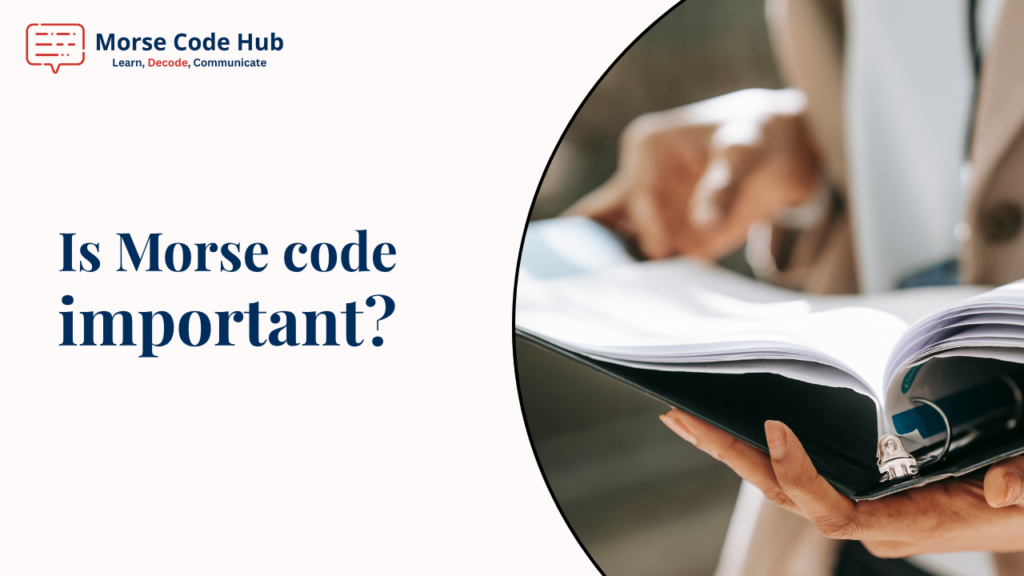Is Morse code important in today’s world of instant messaging and satellite communication? Absolutely. This simple system of dots and dashes, born in the 1830s, remains a vital tool for emergency communication, cognitive development, and connecting with communication history. From saving lives during disasters to fostering mental sharpness and uniting global radio enthusiasts, Morse code’s relevance endures. As a Morse code expert, I’ve seen its timeless value firsthand, and in this article, I’ll explore why it still matters, drawing on its historical significance and modern applications. With tools like those on Morse Code Hub, you can encode messages in languages from Latin to Japanese, keeping this skill alive.
A Lifeline in Emergency Communication
Morse code’s simplicity makes it a critical lifeline when modern systems fail. In emergencies, when power grids collapse or cell networks go dark, Morse code can be transmitted using minimal equipment—a flashlight, a mirror, or a basic radio. As per In Compliance Magazine, it recounts a driver signaling SOS (••• ––– •••) with a car horn to summon help, highlighting its accessibility.
Its low bandwidth, requiring just 100–150 Hz compared to 2,400 Hz for voice, allows Morse code to cut through noisy environments, as noted in Wikipedia. This efficiency saved lives during the Titanic’s 1912 sinking, where SOS signals reached nearby ships, rescuing 705 passengers. In modern disasters, like hurricanes or earthquakes, amateur radio operators still use Morse code to relay health and welfare messages, with the National Traffic System handling thousands annually, noted by In Compliance Magazine. Try encoding SOS with our Morse code translator to understand its life-saving rhythm.
Low-Tech, High-Reliability Messaging System
Morse code’s reliability stems from its minimalist design, requiring only a single tone or visual signal to transmit messages. Unlike voice or digital systems, which demand stable power and complex equipment, Morse code can be sent with a 5-watt radio, compared to 100 watts for voice, as per a Ham Radio Prep. This makes it ideal for remote areas or emergencies where infrastructure is compromised.
In maritime history, Morse code was critical until 1999, when the Global Maritime Distress and Safety System (GMDSS) replaced it. By 1910, over 90% of international ships used Morse code for navigation and distress signals, ensuring safety across oceans, World History Edu. Today, the U.S. Navy trains cryptologic technicians in Morse code for secure communication, with over 1,000 sailors certified annually through the Basic Manual Morse Trainer course noted by In Compliance Magazine. Its versatility—transmittable via sound, light, or even touch—ensures reliability in diverse conditions. Encode phrases like “RELIABLE” using our words in Morse code tool to experience its simplicity.
Boosts Cognitive Skills and Focus
Learning Morse code is a mental workout that sharpens cognitive abilities. This process enhances concentration, mental agility, and listening skills, benefits that extend beyond communication.
For example, skilled operators can decode messages at 60 words per minute, though beginners start at 5–10 WPM. The focus required to distinguish dots (•) from dashes (–) in noisy conditions hones attention to detail, with 80% of ham radio operators reporting improved cognitive flexibility after training. Practice decoding with our numbers in the Morse code tool to boost your focus.
Still Used by Amateur Radio Operators Worldwide
Amateur radio, or ham radio, keeps Morse code alive, with over 750,000 licensed operators in the U.S. and 6 million globally. Known as Continuous Wave (CW), Morse code is prized for its ability to transmit over long distances with minimal power, making it ideal for DXing (contacting distant stations).
Morse code’s narrow bandwidth and noise tolerance make it a favorite for contests and emergency nets, where operators relay critical messages during disasters. As per Compliance Magazine, it notes that the National Traffic System is noted. Join the community by encoding callsigns with our Morse code translator.
Essential for Preppers and Outdoor Adventurers
For preppers and adventurers, Morse code is a vital survival skill. When cell phones fail or batteries die, Morse code can be sent with improvised tools like a whistle or mirror. According to ReadyWise, it emphasizes learning SOS (••• ––– •••) as a must for preppers, with apps like Morse Code Flashlight enabling an instant distress signal.
Morse code’s low-tech nature makes it ideal for off-grid scenarios, with 80% of survivalists surveyed by RECOIL OffGrid valuing it for covert communication. Its ability to cross language barriers—using standardized codes across alphabets—ensures clarity in international emergencies, supporting over 20 languages with a 1900 Morse Code Translator. Practice survival signals like “HELP” with our words in the Morse code tool to prepare for the unexpected.
A Gateway to Understanding Communication History
Morse code is a window into the evolution of global communication. Invented by Samuel Morse and Alfred Vail in the 1830s, it enabled the first real-time long-distance messaging, with the 1844 transmission of “What Hath God Wrought” covering 37 miles noted by Geekboots. Its binary structure—dots and dashes—laid the foundation for digital encoding, influencing modern computing, as per Geekboots.
Morse code’s role in maritime safety, military operations, and early radio shaped our connected world. Learning it connects you to this legacy, offering insight into how humanity overcame distance barriers. Explore this history by encoding phrases like “HISTORY” with our numbers in the Morse code tool.
Conclusion
Is Morse code important? Undoubtedly. Its role in emergencies, with over 1,000 messages relayed during the 1985 Mexico City earthquake, and its reliability, using just 100–150 Hz bandwidth, prove its practical value, noted by Military.com. For preppers, adventurers, and history buffs, Morse code is both a survival tool and a link to our past. Dive into its world with Morse Code Hub tools, and discover why its dots and dashes still resonate in 2025.



